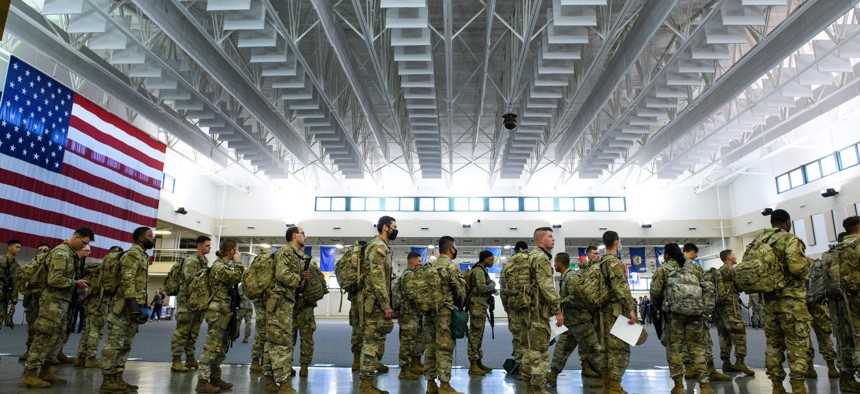
Members of the 1st Armored Brigade Combat Team, 3rd Battalion, 69th Armored Regiment arrive for deployment to Germany, March 2, 2022. Getty Images / Melissa Sue Gerrits
Russia’s Invasion Will Boost 2023 Defense Budget, Top Democrat Says
Rep. Adam Smith: Putin’s war “fundamentally altered what our national security posture” needs to be.
Russia’s invasion of Ukraine will boost the Pentagon’s funding for next year, the chairman of the House Armed Services Committee predicted on Thursday.
“Without question, it’s going to have to be bigger than we thought,” Rep. Adam Smith, D-Wash., said at an American Enterprise Institute event. “The Russian invasion of Ukraine fundamentally altered what our national security posture and what our defense posture needs to be. It made it more complicated and it made it more expensive. I don’t see much way to argue it.”
During annual budget negotiations, Republicans typically push for more defense spending while Democrats overwhelmingly argue for cuts to the military and increased spending on domestic programs. But the bipartisan support for Ukraine could unite both parties around a higher defense budget.
“The political reality is that the Russian incursion in Ukraine has created much more support for an increase in the defense budget,” said Todd Harrison, director for budget analysis at the Center for Strategic and International Studies. “At a minimum, I think [Democrats] won’t oppose it because it’s hard to, politically, at this point given what we’re seeing.”
In December, Congress authorized nearly $778 billion for defense spending in fiscal 2022, which began Oct. 1, though lawmakers have yet to pass a budget to disperse that money. The Biden administration is expected to submit a 2023 budget request this month. Two weeks ago, “sources familiar with the negotiations” told Reuters the request would include more than $800 billion for overall defense spending, including $773 billion for the Defense Department.
Harrison said it’s unlikely the White House will edit its budget request, already two months later than usual, to reflect the conflict in Ukraine. Instead, the White House could amend its proposal later in the year or ask Congress for supplemental funding.
But he predicted that lawmakers will add $10 to $20 billion to a $773 billion request without further prompting.
On Thursday, the White House asked Congress to approve $10 billion in humanitarian, security, and economic assistance for Ukraine. That’s $3.6 billion more than Bloomberg reported last week; it is part of a $32.5 billion package that also includes coronavirus-response money.
“These resources will mean additional defense equipment for Ukraine, lifesaving humanitarian assistance—such as emergency food assistance—for the Ukrainian people, stronger sanctions enforcement, a dedicated task force led by the Department of Justice to go after the ill-gotten gains and other illicit activities of the Russian oligarchs, and additional support for U.S troop deployments to neighboring countries,” acting OMB Director Shalanda Young said in a statement posted to the White House website.
Mackenzie Eaglen, senior fellow at the American Enterprise Institute, predicted that 2023 defense spending will eventually top $800 billion, but also urged Smith to give Congress more flexibility in spending because repeated continuing resolutions shorten the fiscal year and all money expires on Oct. 1.
“That could be just as effective as a higher budget,” she said.
Thousands of American troops have deployed to eastern Europe this year to reassure NATO allies and deter Russia from pushing its troops farther west. If Congress did appropriate more money for the Pentagon, some of it would go to supporting these additional deployments, Harrison said.
But the money would also likely go to buy weapons, aircraft, ships, and submarines to make sure the military can deter both Russia and China, Harrison predicted.
“Now, Congress and DOD, instead of looking at the overall force structure in terms of being able to meet one major theater war at a time…they’re now forced to look at two almost simultaneous wars and that is going to drive a lot more of a increase in demand for force structure,” he said.
Other NATO allies are also poised to increase their defense spending. On Wednesday, France said it would increase defense spending by an unspecified amount. Earlier this week, Germany pledged to boost its defense spending to 2 percent of its GDP, up half a percent. That would make it the 11th NATO member to meet the alliance’s guideline.
If the remaining 19 NATO members met the 2 percent goal, defense spending across the alliance could grow by $80 billion, Cowen & Company analyst Roman Schweizer wrote in a Thursday morning note to investors. If that increase happens, Schweizer estimates $18 billion of that increase could be spending on weapons and equipment.
But spending increases across all alliance members is still unlikely, according to Capital Alpha Partners Byron Callan.
“We have believed that European defense spending could increase, but that has to be assessed on a country-by-country basis,” Callan wrote in a Monday note to investors. “Our assessment has been that ‘front-line states’ such as Poland, Romania, and Finland are more likely to see increases than Spain or Italy, which may feel less of a direct military threat from a more assertive Russia.”
Not everyone, however, agrees that the military needs more money to counter Russia.
“Resources to address the Ukraine crisis should be generated by repurposing existing military funding, not spending more,” William Hartung, a senior research fellow at the Quincy Institute for Responsible Statecraft said in a statement that accompanied the release of an article about the need to cut defense spending.



